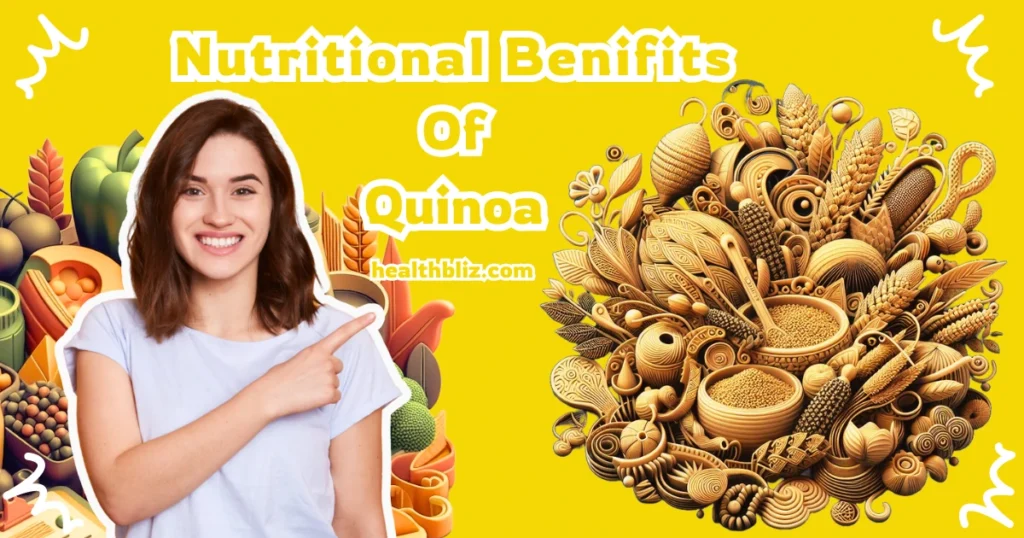
Quinoa has become a superfood in the world of healthy eating. This ancient grain, which has been praised for its nutritional value, versatility, and sustainability, has captured the attention of health-conscious people around the world. It is a nutrient-dense powerhouse that can help you improve your diet. In this article, we’ll go over everything you need to know about this superfood, from its origins and nutritional benefits to cooking tips and creative recipes.
What is Quinoa?
The Andean region of South America is the birthplace of quinoa, a pseudo-cereal pronounced as keen-wah. Indigenous communities, like the Incas, have been growing this grain for thousands of years. Despite its grain-like appearance and culinary uses, quinoa is botanically classified as a seed. You can even mill or grind it into flour, just like oat or buckwheat flour! It belongs to the same family as spinach, Swiss chard, and beets, known as the Amaranthaceae family.
Nutritional Benefits of Quinoa 101
According to the USDA, a 100-gram portion of cooked quinoa provides the following nutritional benefits:
- Protein: Quinoa is a distinctive plant food that provides all nine essential amino acids, qualifying it as a complete protein source. This attribute makes it particularly beneficial for vegetarians and vegans striving to achieve their protein requirements.
- Fiber: Quinoa is high in dietary fiber, which promotes digestive health and regularity. A serving of cooked quinoa contains approximately 2.8 grams of fiber, which promotes satiety and healthy digestion.
- Calories: It contains approximately 120 calories, making it a low-calorie option for those watching their calorie intake.
- Carbohydrates: Contains approximately 21 grams of carbohydrates, primarily in the form of complex carbohydrates, which are beneficial for maintaining energy levels.
- Fat: Contains about 2 grams of fat, primarily healthy unsaturated fats, which are important for overall health.
Vitamins and minerals
- Magnesium: muscle function, nerve function, and bone health are all essential. Quinoa has approximately 64 milligrams of magnesium per 100 grams.
- Phosphorus: It is essential for bone health and tissue maintenance. Quinoa provides approximately 152 milligrams of phosphorus per 100 grams.
- Manganese: Acts as an antioxidant and is involved in bone formation and metabolism. Quinoa provides around 0.6 milligrams of manganese per 100 grams.
- Folate: Required for DNA synthesis and cell growth, especially during pregnancy. Quinoa has approximately 42 micrograms of folate per 100 grams.
- Vitamin B6: Vitamin B6 is essential for metabolic processes, contributes to brain development, and supports immune system functionality. Quinoa offers about 0.1 milligrams of vitamin B6 per 100 grams.
- Zinc: This essential mineral is vital for maintaining optimal health and actively participates in a wide range of chemical reactions that occur within the body.
- Iron: This essential mineral serves numerous vital functions in your body, including oxygen transport in red blood cells.
Other plant-based compounds
Quinoa is rich in various plant compounds that enhance both its taste and health benefits, including:
Flavonoids: Quinoa contains high levels of flavonoids, powerful antioxidants that help fight oxidative stress and reduce the chances of developing chronic conditions such as heart disease and cancer.
Saponins: These plant glycosides defend quinoa seeds from insects and other pests. Since they are bitter, soaking, washing, or roasting them before cooking usually gets rid of them.
Phytic Acid: Quinoa contains phytic acid, an antinutrient that can reduce the absorption of minerals like iron and zinc. However, soaking or sprouting quinoa before cooking can help mitigate this effect.
Oxalates: Quinoa contains oxalates that can interact with calcium, possibly impeding its absorption and heightening the susceptibility of certain individuals to the formation of kidney stones.
Health benefits
Weight Management
Quinoa is a weight-loss-friendly food due to its various properties. Protein is essential for weight management as it can boost metabolism and promote feelings of fullness, potentially helping to prevent obesity and its associated diseases.
Gluten-Free
Quinoa is naturally gluten-free, making it a safe and nutritious option for individuals with celiac disease or gluten sensitivity.
Potential side effects
Blood Sugar Control
Quinoa contains complex carbohydrates that are broken down slowly during digestion. This gradual process results in a gradual rise in blood sugar levels, which helps in maintaining better glycemic control. As a result, quinoa is considered a suitable choice for individuals with diabetes.
Caloric Density
Quinoa is rich in nutrients, but it is also high in calories. Therefore, overeating quinoa without proper portion control in a well-rounded diet may lead to weight gain.
Thyroid Interference
Quinoa is known to contain goitrogens, which are compounds that can potentially disrupt thyroid function by blocking the absorption of iodine. Although this is usually not an issue with moderate quinoa consumption, people with thyroid disorders should consider keeping track of their intake.
Oxalate Concerns
Quinoa contains oxalates, which may bind with calcium and increase the risk of kidney stone formation in sensitive individuals. Those prone to kidney stones may need to moderate their intake of high-oxalate foods like quinoa.
How to Cook Quinoa
When it comes to cooking and preparing quinoa, following these steps can ensure optimal taste and texture:
Step 1: Rinse Quinoa
Cooking quinoa is simple and straightforward, making it an ideal choice for busy individuals and families. Follow these steps to prepare perfect quinoa every time:
Step 2: Combine Quinoa with Water.
For every cup of quinoa, add two cups of water or broth to enhance the flavor. In a saucepan, combine the quinoa and liquid. Bring to a boil.
Step 3: Simmer & Cover
Once the liquid reaches a boil, reduce the heat to low, cover the saucepan, and let the quinoa simmer for 15-20 minutes, or until all of the liquid has been absorbed and the quinoa is tender.
Step 4: Fluff and Serve
Remove the saucepan from the heat and let the quinoa sit, covered, for another 5 minutes. Then, using a fork, fluff the quinoa to separate the grains before serving hot as a nutritious side dish or base for a variety of recipes.
Other Ways to Enjoy Quinoa
Quinoa’s versatility goes beyond traditional grain dishes. Here are some other ways to include quinoa in your meals:
1: Quinoa Salad
Make a refreshing and nutritious salad by combining cooked quinoa, fresh vegetables, herbs, and a zesty dressing. Add cherry tomatoes, cucumbers, bell peppers, avocado, and feta cheese for a burst of flavor and color.
2: Quinoa Breakfast Bowl
Start your day right with a hearty quinoa breakfast bowl. For a filling and nutritious breakfast, top cooked quinoa with Greek yogurt, fresh fruit, nuts and seeds, and a drizzle of honey.
3: Quinoa Stuffed Peppers
Quinoa stuffed peppers are a flavorful and filling entrée option. Fill bell peppers with cooked quinoa, black beans, corn, diced tomatoes, and spices, then bake until tender for a delicious vegetarian meal that the entire family will enjoy.
4: Quinoa Pudding
Indulge your sweet tooth with quinoa pudding, a healthier alternative to traditional rice pudding. Cook the quinoa with milk, vanilla, cinnamon, and a drizzle of honey or maple syrup until creamy and tender. Serve warm or cold, with fresh fruit and a sprinkle of cinnamon on top.
Frequently Asked Questions (Quinoa 101)
Q1: Can I eat quinoa everyday?
A1: Yes, you can eat quinoa every day.
Q2: Is quinoa better than oats?
A2: Quinoa is a complete protein, whereas oats contain soluble fiber. Both provide distinct benefits, making them excellent additions to a healthy diet.
The Bottom Line
By incorporating quinoa into your diet and substituting it for grains such as rice or wheat, you can enhance the nutrient profile of your meals and take a step towards a healthier lifestyle.
People Also Like To Read:


